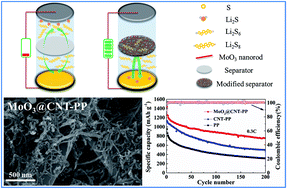An interwoven MoO3@CNT scaffold interlayer for high-performance lithium–sulfur batteries†
Abstract
Lithium–sulfur (Li–S) batteries have attracted increasing attention in the past few decades due to the extremely high energy density, low cost and non-toxicity of sulfur. But the poor conductivity of sulfur and particularly the migration of soluble polysulfides greatly hindered the application of Li–S batteries. Herein, we report a novel strategy for trapping polysulfides by coating a separator with an interwoven framework of MoO3 nanorods and carbon nanotubes (CNTs) as the interlayer in Li–S batteries. The interwoven scaffold-like MoO3@CNT network provides abundant conducting channels and pathways for ions and electrons, leading to high rate capabilities. While the MoO3@CNT interlayer acting as a barrier effectively mitigates the shuttle effect in Li–S batteries, the MoO3 nanorods enfolded by CNTs uniformly play an important role in immobilizing sulfur species. Consequently, the electrochemical performances of Li–S batteries are improved, giving rise to higher capacities with a longer cycling life. The Li–S batteries with the MoO3@CNT interlayer can deliver a specific capacity of 755 mA h g−1 after 200 cycles at a current density of 0.3C, and show an excellent rate capability with a capacity of 655 mA h g−1 at 3C.



 Please wait while we load your content...
Please wait while we load your content...